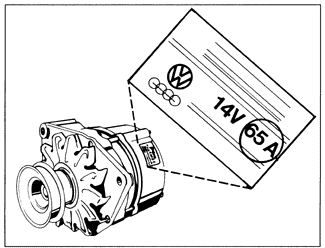5. Charging systemThe charging system provides the current necessary to keep the battery charged. The system includes an alternator driven from the engine crankshaft by a V-belt to generate the charging current, and a voltage regulator to control the rate at which the battery is charged. The charging capacity of the alternator installed on each car depends on the type and number of electrical accessories. The alternator rating can be found on its housing as shown in Fig. 5-1. The voltage regulator is mounted on the end of the alternator housing. Voltage regulators and alternators are available as replacement parts from an authorized Volkswagen dealer. Volkswagen remanufactured alternators are also available as an alternative to new ones.

To prevent damage to the alternator or regulator when making tests or repairs, make all connections with negative (-) to negative, and positive (+) to positive unless directed otherwise. Even momentary contact with a conductor of the wrong polarity can cause damage to the alternator's diodes. Make certain that the battery ground strap is connected to the battery's negative (-) terminal and that the cable to terminal 30 on the starter is connected to the battery's positive (+) terminal. Never operate the engine with the battery disconnected. Never operate the alternator with its output terminal (B+) disconnected and the other terminals connected. Never short, bridge, or ground any terminals of the charging system except as specifically described in 5.1 Charging System Troubleshooting. |